高二英语必修六导学案.doc
- 格式:doc
- 大小:159.50 KB
- 文档页数:7
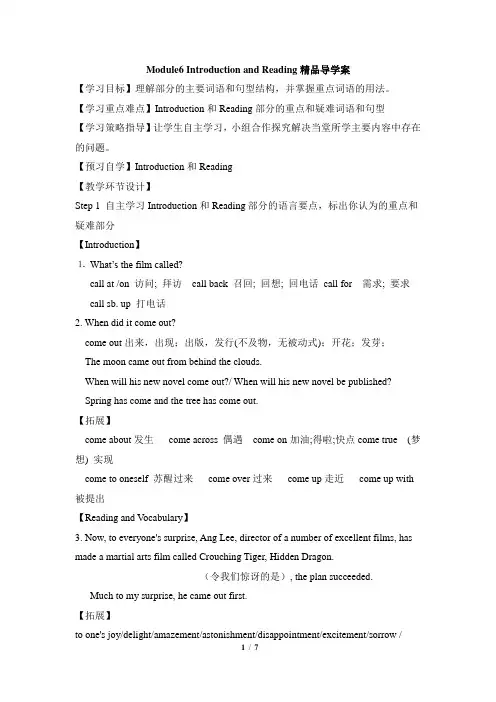
Module6 Introduction and Reading精品导学案【学习目标】理解部分的主要词语和句型结构,并掌握重点词语的用法。
【学习重点难点】Introduction和Reading部分的重点和疑难词语和句型【学习策略指导】让学生自主学习,小组合作探究解决当堂所学主要内容中存在的问题。
【预习自学】Introduction和Reading【教学环节设计】Step 1 自主学习Introduction和Reading部分的语言要点,标出你认为的重点和疑难部分【Introduction】⒈What’s the film called?call at /on 访问; 拜访call back 召回; 回想; 回电话call for 需求; 要求call sb. up 打电话2. When did it come out?come out出来,出现;出版,发行(不及物,无被动式);开花;发芽;The moon came out from behind the clouds.When will his new novel come out?/ When will his new novel be published? Spring has come and the tree has come out.【拓展】come about发生come across 偶遇come on加油;得啦;快点come true (梦想) 实现come to oneself 苏醒过来come over过来come up走近come up with 被提出【Reading and V ocabulary】3. Now, to everyone's surprise, Ang Lee, director of a number of excellent films, has made a martial arts film called Crouching Tiger, Hidden Dragon.______________________(令我们惊讶的是), the plan succeeded.Much to my surprise, he came out first.【拓展】to one's joy/delight/amazement/astonishment/disappointment/excitement/sorrow /sadnessin surprise◆My teacher looked at me _______ and asked me what I was doing.A. by surpriseB. in surpriseC. to surpriseD. with surprise4. The film belongs to a type of Chinese story called wuxia.belong to 属于此短语不能用于进行时态,无被动Remember to put the book where it belongs.◆—Do you know who the car parking there _________?—That tall man over there.A. belonging toB. is belonging toC. belongs toD. is belonged to◆The film, _____ a type of Chinese story called wuxia, _____ popular as well as in foreign countries.A. belongs to; isB. belong to; areC. belonging to; isD. belonging to; are翻译:中国是一个属于第三世界的发展中国家。
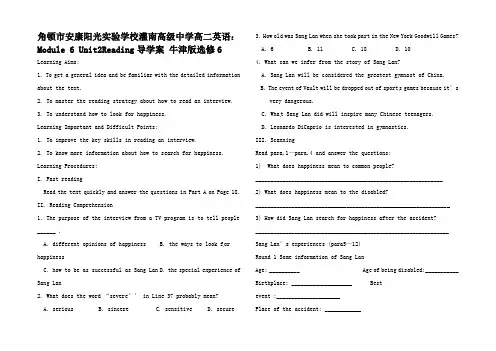
角顿市安康阳光实验学校灌南高级中学高二英语:Module 6 Unit2Reading导学案牛津版选修6 Learning Aims:1. To get a general idea and be familiar with the detailed information about the text.2. To master the reading strategy about how to read an interview.3. To understand how to look for happiness.Learning Important and Difficult Points:1. To improve the key skills in reading an interview.2. To know more information about how to search for happiness. Learning Procedures:I. Fast readingRead the text quickly and answer the questions in Part A on Page 18. II. Reading Comprehension1. The purpose of the interview from a TV program is to tell people ______ .A. different opinions of happinessB. the ways to look for happinessC. how to be as successful as Sang LanD. the special experience of Sang Lan2. What does the word “severe’’ in Line 37 probably mean?A. seriousB. sincereC. sensitiveD. secure 3. How old was Sang Lan when she took part in the New York Goodwill Games?A. 6B. 11C. 18D. 104. What can we infer from the story of Sang Lan?A. Sang Lan will be considered the greatest gymnast of China.B. The event of Vault will be dropped out of sport s games because it’svery dangerous.C. Wha t Sang Lan did will inspire many Chinese teenagers.D. Leonardo DiCaprio is interested in gymnastics.III. ScanningRead para.1—para.4 and answer the questions:1) What does happiness mean to common people?______________________________________________________________2) What does happiness mean to the disabled?________________________________________________________________3) How did Sang Lan search for happiness after the accident?________________________________________________________________ Sang Lan’s experiences (para5—12)Round 1 Some information of Sang LanAge: __________ Age of being disabled:___________ Birthplace: ____________________ Bestevent :_____________________Place of the accident: ____________Round 2 Important events1981 ___________________________ 1987___________________________1991 ___________________________ 1998____________________________Round 3 Use as many adjectives as possible to describe Sang Lan.___________________________________________________________________ __________IV. Task-based readingRead the text and fill in each blank with a proper word.Title: The search for happiness必备短语和句型I. Find out the following important phrases.1. 远离;除了2.取得成功3.实现目标4.以防…5. 适应新生活6. 心情好7.追求8.使…振作9.献身于…,致力于…10.被…包围11.意识到…, 明白….12. 集中于…VI. Underline and recite the following important sentences in the text.1.To some, happiness is being surrounded by family and friends.对一些人来说,幸福就是有家人和朋友陪伴在自己身边。
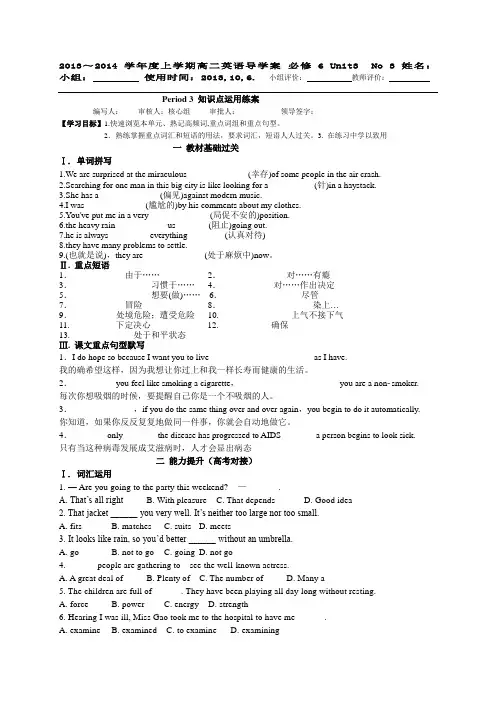
2013~2014学年度上学期高二英语导学案必修 6 Unit3 No 3姓名:小组:使用时间:2013,10,6. 小组评价:教师评价:Period 3 知识点运用练案编写人:审核人:核心组审批人:_________ 领导签字:_________【学习目标】1.快速浏览本单元、熟记高频词,重点词组和重点句型。
2.熟练掌握重点词汇和短语的用法,要求词汇,短语人人过关。
3. 在练习中学以致用一教材基础过关Ⅰ. 单词拼写1.We are surprised at the miraculous______________(幸存)of some people in the air crash.2.Searching for one man in this big city is like looking for a __________(针)in a haystack.3.She has a______________(偏见)against modern music.4.I was______________(尴尬的)by his comments about my clothes.5.You've put me in a very______________(局促不安的)position.6.the heavy rain ___________ us _______(阻止)going out.7.he is always _________everything________ (认真对待)8.they have many problems to settle._______ _______9.(也就是说),they are ____ _________(处于麻烦中)now。
Ⅱ. 重点短语1.____________由于……2._______________对……有瘾3.__________________习惯于……4.____________对……作出决定5.__________________想要(做)……6.__________________尽管7.____________冒险8._____________________染上…9.________ 处境危险;遭受危险10. ________________上气不接下气11. __________下定决心12.____________确保13. ______________处于和平状态Ⅲ. 课文重点句型默写1.I do hope so because I want you to live________________________as I have.我的确希望这样,因为我想让你过上和我一样长寿而健康的生活。
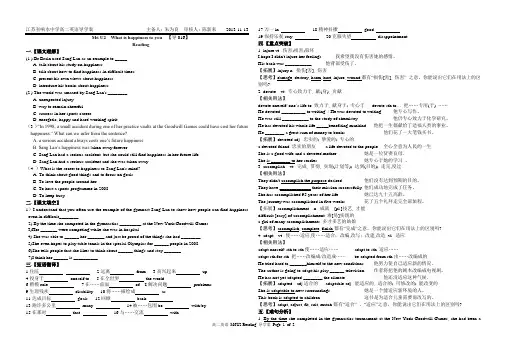
M6 U2 What is happiness to you 【导016】Reading一.【课文理解】(1.) Dr Brain used Sang Lan as an example to _____.A. talk about his study on happinessB. talk about how to find happiness in difficult timesC. present his own views about happinessD. introduce his books about happiness(2.) The world was amazed by Sang Lan's ________.A. unexpected injuryB. way to remain cheerfulC. success in her sports careerD. energetic, happy and hard-working spirit(3.)“In 1998, a small accident during one of her practice vaults at the Goodwill Games could have cost her future happiness.” What can we infer from the sentence?A. a serious accident always costs one’s future happinessB. Sang Lan’s happiness was t aken away foreverC. Sang Lan had a serious accident, but she could still find happiness in her future life.D. Sang Lan had a serious accident and she was taken away(4 .)What is the secret to happiness to Sang Lan's mind?A. To think about good things and to focus on goals.B. To love the people around her.C. To host a sports programme in 2008.D. To keep busy.二.【课文填空】1)I understand that you often use the example of the gymnast Sang Lan to show how people can find happiness even in difficult________.2) By the time she competed in the gymnastics _________ at the New York Goodwill Games.3)Her _______ were competing while she was in hospital.4) She was able to ______ her _______ and just be proud of the things she had ________.5)She even hopes to play table tennis in the special Olympics for ______ people in 2008.6)She tells people that she likes to think about ______ things and stay _______.7)I think her ______ is __________.三.【短语翻译】1.住院2.远离from3.高兴起来up4.投身于oneself to5.在全世界the world6.楷模role7.在……前面of8.解决问题problems9.生理残疾disability 10.将……描绘成as11.达成目标goals 12.回顾back13.跑许多公里many 14.被……包围be with/by15.在那时that 16.与……交流with 17.万一in 18.精神抖擞good19.保持乐观stay 20.克服失望disappointment四.【重点突破】1. injure vt. 伤害;损害;毁坏I hope I didn't injure her feelings. 我希望我没有伤害她的感情。
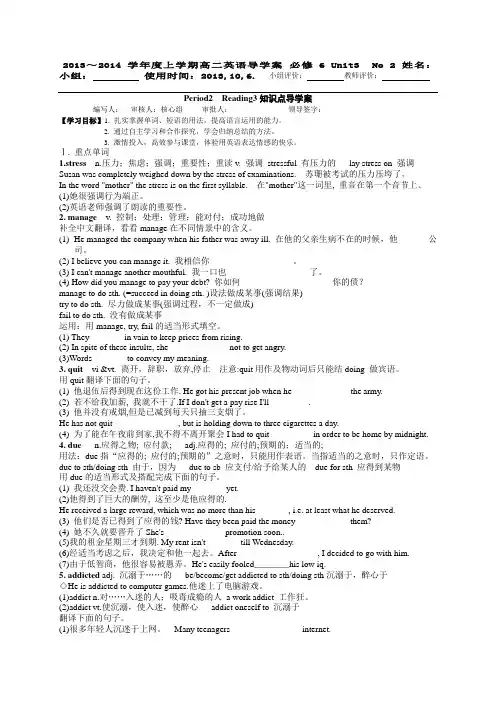
2013~2014学年度上学期高二英语导学案必修 6 Unit3 No 2姓名:小组:使用时间:2013,10,6. 小组评价:教师评价:Period2 Reading3知识点导学案编写人:审核人:核心组审批人:_____________ 领导签字:_____________【学习目标】1. 扎实掌握单词、短语的用法,提高语言运用的能力。
2. 通过自主学习和合作探究,学会归纳总结的方法。
3. 激情投入,高效参与课堂,体验用英语表达情感的快乐。
Ⅰ. 重点单词1.stress n.压力;焦虑;强调;重要性;重读v. 强调stressful 有压力的lay stress on 强调Susan was completely weighed down by the stress of examinations. 苏珊被考试的压力压垮了。
In the word "mother" the stress is on the first syllable. 在"mother"这一词里, 重音在第一个音节上。
(1)她很强调行为端正。
___________________________________________(2)英语老师强调了朗读的重要性。
_____________________________2. manage v. 控制;处理;管理;能对付;成功地做补全中文翻译,看看manage在不同情景中的含义。
(1)He managed the company when his father was away ill. 在他的父亲生病不在的时候,他_______公司。
(2) I believe you can manage it. 我相信你___________________。
(3) I can't manage another mouthful. 我一口也___________________了。

Book6 Unit4 Global warming 导学案(Period One: Reading)课前案Skim the text and finish the following information.1.What’s the main topic of the passage?The main topic of the passage is about .2.Who wrote the magazine article? What is the name of the magazine?wrote the magazine article; the name of the magazine is .3.What are the names of the three scientists mentioned in the article?The names of the three scientists mentioned in the article are , , and .Do they agree with one another? .4.The passage can be divided into three sections, match them with the main idea of each section.Part1.(1) A. How global warming comes aboutPart2. (2-5) B. List two different attitudes towards global warmingPart3. (6) C. Introduction of global warmingPart4. (7) D. Whether people should do something about global warming课中案学习目标:1.To learn some important words and phrases about global warming.2.To develop the reading skills by skimming and scanning the passage.3.To strengthen the awareness of environment protection .Step 1 Fast readingRead the text quickly and choose the best answers.1. How much did the temperature rise in the 1900s?A.One degree Fahrenheit. B.One Celsius.C.Two degrees. D.Thirty degrees Celsius.2.What causes the earth’s temperature increasing?A. Cutting treesB. Wasting the farmland.C. Running out of the river waterD. Burning fossil fuels.3.Which of the following is Dr. Janice F oster’s opinion?A. The result of the temperature increase will be serious.B. The amount of warming is nothing serious.C. We needn’t worry about high levels of carbon dioxide.D. Global warming is a natural phenomenon.4.According to George Hambley, .A. Global warming is a serious problem.B. There is no need to worry about global warming.C. The levels of CO2 in the air will become lower in the future.D. More animals will make greenhouse gases decrease.5. We can infer from the text that __________.A. the debate about the effects of global warming has not been settled.B. the greenhouse effect is the result of people’s actions.C. all scientists think it is important to reduce the amount of CO2 in the atmosphere.D. reducing greenhouse gases will immediately decrease the earth’s temperature. Step2 Careful reading Read Para.2 to Para.6 and fill in the blanks.(Para.2-Para.3)The reasons for global warminggreenhouse gases(Para.4-Para.5)The levels of carbon dioxide have increased greatly over the last . According to Dr.Charles Keeling, from to , the amount in the atmosphere wentup from around parts to around parts per millionDr.Janice Foster believes over the next century ,the amount of warming could be as lowas degrees Celsius, but it could also be as high as degrees.(Para.6)Different opinions about global warming.Dr. Foster(a catastrophe)George Hambley(a positive thing)1.a rise in2.severe storms, __________,__________, famines3.the spread of4.the disappearance of1.Plants will2.Crops will3.There will be a greater rangeofStep3 Further reading True or False()1.The temperature in the last century seemed to increase much.()2. Everyone believes that global warming is caused by the activities of humans.()3. The rise in carbon dioxide is causing a steady increase in global warming.()4. George Hambley believes that global warming will do good rather than harm to the earth.()5. It is clear what the effects of global warming will be.Step 4 Fill in the blanks to retell the passage.The temperature of the earth 1 (rise) about one degree during the 20th century. How has this come 2 ? All scientists subscribe 3 the view that it is human activity 4 has caused the 5 (globe) warming rather 6 a random but natural phenomenon. Some scientists think we add large 7 (quantity) of carbon dioxide to the air. Some scientists believe the burning of more and more fossil fuels 8 (have) resulted in the increase of carbon dioxide. Greenhouse gases continue to build 9 . It may be a catastrophe but George 10 (state) that it is a positive thing.Step 5 Free talk — a short speech 能力提升Between the two opinions ,decide on one to have a discussion in you group and then choose a speaker to give a speech on behalf of your group. The following information may help you.Step 6 Summary课后案I.课外延伸阅读Further reading about global WarmingGlobal warming is the unusually rapid increase in Earth’s average surface temperature ove century primarily due to the greenhouse gases released as people burn fossil fuels. The global averagesurface temperature rose 0.6 to 0.9 degrees Celsius (1.1 to 1.6°F) between 1906 and 2005, and the rate of temperature increase has nearly doubled in the last 50 years. Temperatures are certain to go up further.Earth’s natural greenhouse effect Earth’s temperature begins with the Sun. Roughly 30 percent ofincoming sunlight is reflected back into space by bright surfaces like clouds and ice. Of the remaining 70percent, most is absorbed by the land and ocean, and the rest is absorbed by the atmosphere. The absorbedsolar energy heats our planet. As the rocks, the air, and the seas warm, they radiate “infrared radiation). From the surface, this energy travels into the atmosphere where much of it is absorbedby water vapor and long-lived greenhouse gases such as carbon dioxide and methane. When they absorbthe energy radiating from Earth’s surface, microscopic water or greenhouse gas molecules turn into tiny heaters— like the bricks in a fireplace, they radiate heat even after the fire goes out. They radiate in alldirections. The energy that radiates back toward Earth heats both the lower atmosphere and the surface,enhancing the heating they get from direct sunlight. This absorption and radiation of heat by the atmosphere—the natural greenhouse effect—is beneficial for life on Earth. If there were no greenhouseeffect, the Earth’saverage surface temperature would be a very chilly -18°C (0°F) instead of the comfortable 15°C (59°F) that it is today.What has scientists concerned now is that over the past 250 years, humans have been artificiallyraising the concentration of greenhouse gases in the atmosphere at an ever-increasing rate, mostly byburning fossil fuels, but also from cutting down carbon-absorbing forests. Since the Industrial Revolutionbegan in about 1750, carbon dioxide levels have increased nearly 38 percent as of 2009 and methanelevels have increased 148 percent.II.拓展提高书面表达如何解决全球变暖是我们全人类共同面临的一个难题。
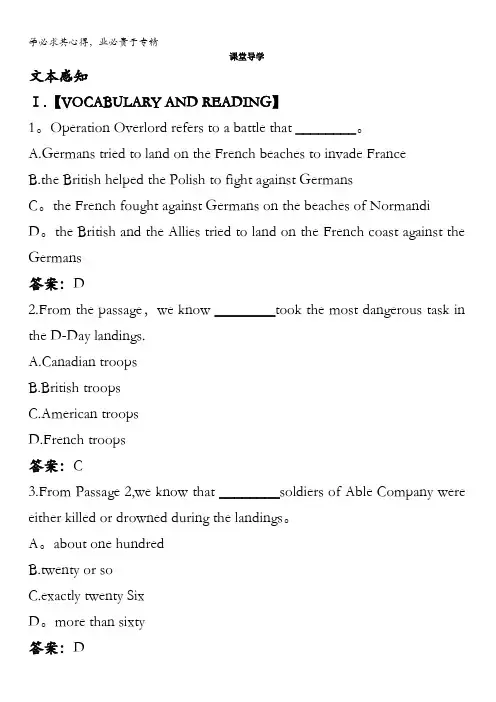
课堂导学文本感知Ⅰ.【VOCABULARY AND READING】1。
Operation Overlord refers to a battle that ________。
A.Germans tried to land on the French beaches to invade FranceB.the British helped the Polish to fight against GermansC。
the French fought against Germans on the beaches of NormandiD。
the British and the Allies tried to land on the French coast against the Germans答案:D2.From the passage,we know ________took the most dangerous task in the D-Day landings.A.Canadian troopsB.British troopsC.American troopsD.French troops答案:C3.From Passage 2,we know that ________soldiers of Able Company were either killed or drowned during the landings。
A。
about one hundredB.twenty or soC.exactly twenty SixD。
more than sixty答案:D4。
The sentence “Two men.Two rifles.This was Able Company’s contribution to D-Day" gives us a suggestion that ________。
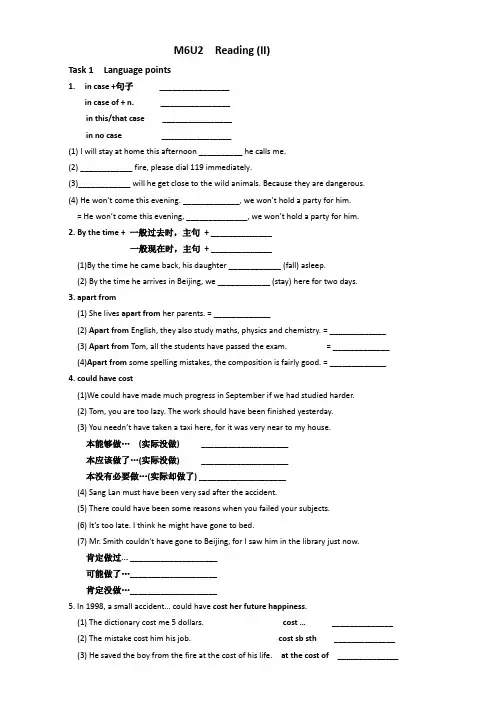
M6U2 Reading (II)Task 1 Language points1.in case +句子________________in case of + n. ________________in this/that case ________________in no case ________________(1) I will stay at home this afternoon __________ he calls me.(2) ____________ fire, please dial 119 immediately.(3)____________ will he get close to the wild animals. Because they are dangerous.(4) He won’t come this evening. _____________, we won’t hold a party for him.= He won’t come this evening, ______________, w e won’t hold a party for him.2. By the time + 一般过去时,主句+ ______________一般现在时,主句+ ______________(1)By the time he came back, his daughter ____________ (fall) asleep.(2) By the time he arrives in Beijing, we ____________ (stay) here for two days.3. apart from(1) She lives apart from her parents. = _____________(2) Apart from English, they also study maths, physics and chemistry. = _____________(3) Apart from Tom, all the students have passed the exam. = _____________(4)Apart from some spelling mistakes, the composition is fairly good. = _____________ 4. could have cost(1)We could have made much progress in September if we had studied harder.(2) Tom, you are too lazy. The work should have been finished yesterday.(3) You n eedn’t have taken a taxi here, for it was very near to my house.本能够做…(实际没做) ____________________本应该做了…(实际没做) ____________________本没有必要做…(实际却做了) ____________________(4) Sang Lan must have been very sad after the accident.(5) There could have been some reasons when you failed your subjects.(6) It’s too late. I think he might have gone to bed.(7) Mr. Smith couldn't have gone to Beijing, for I saw him in the library just now.肯定做过... ____________________可能做了…____________________肯定没做…____________________5. In 1998, a small accident… could have cost her future happiness.(1) The dictionary cost me 5 dollars. cost … ______________(2) The mistake cost him his job. cost sb sth ______________(3) He saved the boy from the fire at the cost of his life. at the cost of ______________6. Sang Lan was not aware of the change until it was too late.变倒装句:Not until _____________________________________________________________变强调句: It was not until_______________________________________________________直到看了电影Dearest我才意识到我是幸福的。
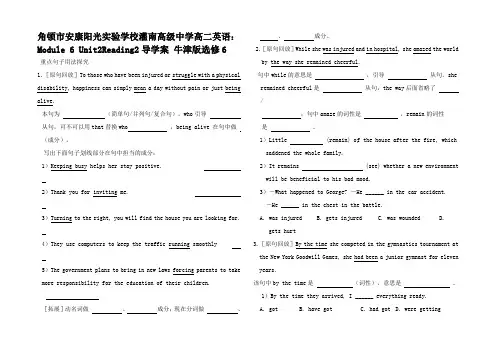
角顿市安康阳光实验学校灌南高级中学高二英语:Module 6 Unit2Reading2导学案 牛津版选修6重点句子用法探究1.[原句回放]To those who have been injured or struggle with a physical disability, happiness can simply mean a day without pain or just being alive.本句为 (简单句/并列句/复合句),who 引导 从句,可不可以用that 替换who ,being alive 在句中做 (成分)。
写出下面句子划线部分在句中担当的成分:1)Keeping busy helps her stay positive.2)Thank you for inviting me.3)Turning to the right, you will find the house you are looking for.4)They use computers to keep the traffic running smoothly5)The government plans to bring in new laws forcing parents to takemore responsibility for the education of their children.[拓展]动名词做 、 成分;现在分词做 、 、 成分。
2.[原句回放]While she was injured and in hospital, she amazed the world by the way she remained cheerful.句中while 的意思是 ,引导 从句。
she remained cheerful 是 从句,the way 后面省略了 /;句中amaze 的词性是 ,remain 的词性是 。
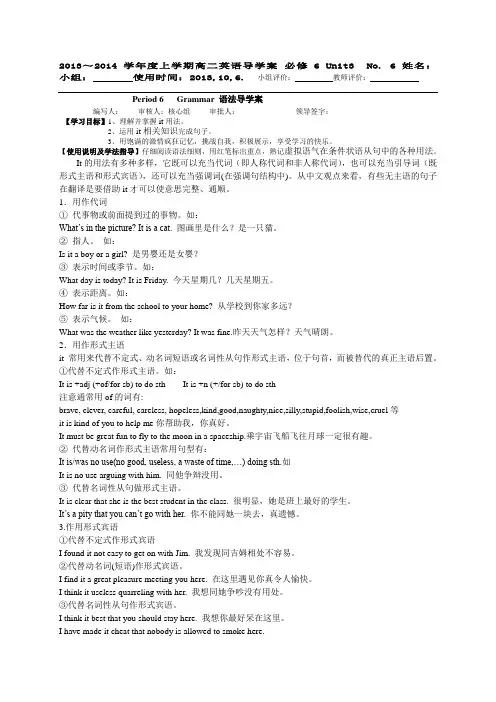
2013~2014学年度上学期高二英语导学案必修 6 Unit3 No. 6 姓名:小组:使用时间:2013,10,6. 小组评价:教师评价:Period 6 Grammar 语法导学案编写人:审核人:核心组审批人:_____________ 领导签字:_____________【学习目标】1、理解并掌握it用法。
2、运用it相关知识完成句子。
3、用饱满的激情疯狂记忆,挑战自我,积极展示,享受学习的快乐。
【使用说明及学法指导】仔细阅读语法细则,用红笔标出重点,熟记虚拟语气在条件状语从句中的各种用法。
It的用法有多种多样,它既可以充当代词(即人称代词和非人称代词),也可以充当引导词(既形式主语和形式宾语),还可以充当强调词(在强调句结构中)。
从中文观点来看,有些无主语的句子在翻译是要借助it才可以使意思完整、通顺。
1.用作代词①代事物或前面提到过的事物。
如:What’s in the picture? It is a cat. 图画里是什么?是一只猫。
②指人。
如:Is it a boy or a girl? 是男婴还是女婴?③表示时间或季节。
如:What day is today? It is Friday. 今天星期几?几天星期五。
④表示距离。
如:How far is it from the school to your home? 从学校到你家多远?⑤表示气候。
如:What was the weather like yesterday? It was fine.昨天天气怎样?天气晴朗。
2.用作形式主语it 常用来代替不定式、动名词短语或名词性从句作形式主语,位于句首,而被替代的真正主语后置。
①代替不定式作形式主语。
如:It is +adj (+of/for sb) to do sth It is +n (+/for sb) to do sth注意通常用of的词有:brave, clever, careful, careless, hopeless,kind,good,naughty,nice,silly,stupid,foolish,wise,cruel等it is kind of you to help me你帮助我,你真好。
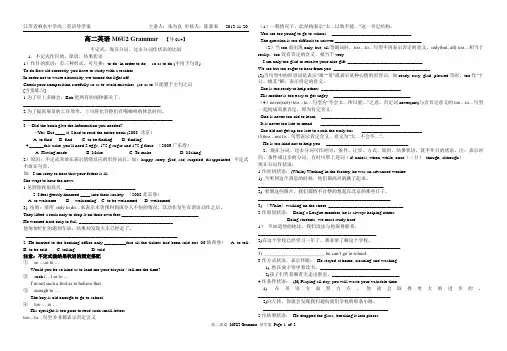
江苏省响水中学高二英语导学案主备人:朱为良审核人:陈新来2013-11-20高二英语M6U2 Grammar 【导014】不定式、现在分词、过去分词作状语的比较1、不定式作目的、原因、结果状语1)作目的状语:有三种形式,可互换:to do, in order to do, so as to do (不用于句首)To do first aid correctly, you have to study with a teacher.In order not to waste electricity, we turned the light off.Check your composition carefully so as to avoid mistakes. (so as to只能置于主句之后[当堂练习]1.为了早上多睡会,Bob把所有的闹钟都关了。
_________________________________________________________2.为了提高雇员的工作效率,上司将允许他们有喝咖啡的休息时间。
______________________________________________________________3.—Did the book give the information you needed?—Yes. But ____ it, I had to read the entire book.(2008 北京)A. to findB. findC. to be findingD. finding4.______this cake, you'll need 2 eggs, 175 g sugar and 175 g flour. (2006广东卷)A. Having madeB. MakeC. To makeD. Making2)原因:不定式常放在表示情绪反应的形容词后。
Module 6 Unit 1 Grammar班级:_________小组:_________ 姓名:___________ 等级:_______【学习目标】了解虚拟语气的基本用法★预习案Previewing Case虚拟语气(The Subjunctive Mood )虚拟语气表示说话人的意愿、假设、猜测或建议。
虚拟语气不表示客观存在的事实,谓语动词用特殊的形式表示虚拟语气。
一、虚拟语气在if条件状语中的用法:1.表示与现在事实相反时的谓语形式。
If条件从句主句过去式(be----were)would (should/could/might) + 动词原形例如:If Tom were hungry, he would eat the bread.(In fact, Tom isn’t hungry.)2.表示与过去事实相反的谓语形式。
If条件从句主句had + 过去分词would (should/could/might) + have +过去分词例如:If I had left a little earlier, I would have caught the early bus.(In fact, I didn’t catch the bus.)3.表示与将来事实相反的谓语形式。
If条件从句主句动词过去式(be----were)should + 动词原形would (should/could/might) + 动词原形were to + 动词原形例如:If they came tomorrow, we would tell them about it.(In fact, they won’t come tomorrow.)二、虚拟语气在名词性从句中的用法:名词性从句有__________, ___________, ____________ 和_______________四种。
1. 动词wish后的宾语从句中,谓语动词可用过去式表示现在的情况,用过去完成式表示过去的情况,用“would/might/could/ + 动词原形”表示将来的情况。
高二英语 Module 2 A Job Worth Doing 6导学案Job Worth Doing6I Function: 情态动词+have done(一)表示对过去发生的事进行推测must have done:一定已经……(只用于肯定句)can’t / couldn’t have done 一定不会……(用于否定句,疑问句)might/may have done 可能已经……(用于肯定句,否定句,可能性较小)(二)表示对过去的虚拟should/ought to have done 过去本应该做而实际上没做shouldn’t/ought not to have done 过去本不应该做而实际上做了needn’t have done 本来不必做某事而做了might/could have done 本来可以做某事而没做(表示遗憾没做某事)would have done 本来要做某事但因某种原因未做[练一练]1、She ______ have left school, for her bike is still here、A、can’tB、wouldn’tC、shouldn’tD、needn’t2、-I can’t find my purse anywhere、-You ____ have lost it while shopping、A、 mayB、 canC、 shouldD、 would3、 Peter ____ be really difficult at times even though he’s a nice person in general、A、 shallB、 shouldC、 canD、 must4、 Thank you for all your hard work last week、 I don’t think we ____ it without you、A、 can manageB、 could have managedC、 could manageD、 can have managed5、 What a pity、 Considering his ability and experience, he ____ better、A、 need have doneB、 must have doneC、 can have doneD、 might have doneII Cultural Corner1、Questions:(1)How many jobs does the passage refer to? (2)What are the ten fastest growing jobs related to?(3)Why will we need more travel agents in the future?2、 Choose T or F (1)According to a survey published by an American university,the ten fastest growing jobs will be related to computers and health、 ( )(2) There will be a fall in the demand for health care professionals、 ( )(3)We won’t need any social workers because of the development of high-technology、 ( )(4)10 million American suffer from speech or language problems、( )(5)There will also be a rise in the demand for guides and travel agents、 ( )III、 Language points:1、require sb、 to do sth、=sb、 be required to do sth、 require doing= require to be done (主语常是物,主动表被动,不及物动词后介词不能省) require +that clause (从句用should + do)2、 demand: n、需要,需求 be in demand 或 a/the demand forV 需要 demand to do sth、 demand of sb、 to do sth、 demand sb of sth demand sth from sb demand + that clause (从句用should +do)3、 apply(to sb)for sth apply sth 把某物应用于apply oneself to。
2013~2014学年度上学期高二英语导学案必修6 Unit3 A healthy life No. 5 姓名:小组:使用时间:2013,10,6. 小组评价:教师评价:Period 5 Using language 语言运用练习学案编写人:审核人:核心组审批人:_____________ 领导签字:_____________一教材基础过关Ⅰ. 单词拼写1. The d_____________ look on his face suggested that he failed in the exam again.2. A__________ often take more risks than adults.3. It will be a long time before you get a__________ to the local food.4. As a judge, he has a good j______________ and never judges a person by his appearance.5. As is known, we need food and water for s______________.6. It's i_______________ to read people's private letters without permission.7. Much to our _______________(失望),he will not be able to come.8. My children have become hopelessly _______________ (沉溺于)to television.9. _____________(精神) health is as important as physical health.10. Nowadays many supermarket doors can shut ___________________ (自动).11. You’ve put me in an ___________________ (令人尴尬的) position.12. It is an attempt to ___________________ (强化) our competitive ability.III.重点短语1) 处境危险_______________________2)许多不同的病毒___________________3)破坏某人的免疫系统___________ 4)不再_____________5)一种治愈……的方法______________6)确保____________________7)和……共享______________________8)是否_____________________10)由于同样的原因__________________二能力提升(高考对接)I. 词汇运用:单项选择1. Doctors are doing research to find out what happens physically when people _________ smoking.A. quitB. declineC. departD. Reserve2. The great success of this programme has been largely ___________ the support given by the 10 local business men.A. instead ofB. thanks toC. due toD. as a consequence3.Cooperation or teamwork,the importance of which is often______,plays an important part in football matches.A.stressed B.laid stress C.paid much attention D.Talked4.It is generally believed that constant reading and comprehending can ______ our mentalability of comprehension while physical exercise can help build up our body.stress B. effect C. strengthen D. Decide5 If a chemist _______guilty of selling drugs unfit for youngsters, his qualification willautomatically cease, according to regulation 34 in the administrative section.A. approvesB. appealsC. provesD. turn out6. As is well known to us all, medicine should not be kept where it is _____to children.A.accessible B.apparent C.allergic D.Automatic7. Jane Goodall said “Chimpanzees are far more_________intelligent than we ever realize”A. physicallyB. morallyC. emotionallyD. Mentally8.As we all know, the government is now making every _________ to set up a harmonious society.A. effortB. effectC. measureD. Performance9. His body temperature has been__ for 3 days, the highest point reaching 40.5degrees centigrade.A. acidB. abruptC. abnormalD. Accessible10. He was __________ much surprised at the news that the amateur athlete beat the professional one who ranked top ten.A. apparentlyB. rarelyC. secretlyD. desperately11.This magazine is very __________with young people, who like its content and style.A. familiarB. popularC. similarD. particular12. Emergency line operators must always __________calm and make sure that they get all the information they need to send help.A. growB. appearC. becomeD. stay13. Despite such a big difference in __________ towards what one eats, there is no doubt that people in the west regard the Chinese food as something special.A. pointB. ideaC. attitudeD. sight14. If the firms failed to make enough money, they would __________.A. close downB. call offC. turn downD. set off15.She devoted herself __________to her research and it earned her a good reputation in her field.A. stronglyB. extremelyC. entirelyD. freely16. People try to avoid public transportation delays by using their own cars, and this __________creates further problems.A. in shortB. in caseC. in doubtD. in turnⅡ. 完成句子1.We are determined to get our rights__________________________________.(cost)我们决定不惜一切代价争取我们的权力。
编 号 060401 课 题 Unit 4 Global warming 周 次 主 编 人 审核人 课 时 姓 名 班级和组别 组 评 师 评 学习目标:Learn how to read them; pay attention to the pronunciations. Get to know some words based on the original ones. 教学重难点:How to master the key words. 教学与教法:自主学习,小组讨论 教学过程: 一、 揭示目标、学法指导: Learn how to read them; pay attention to the pronunciations. 二、 学生自学、教师巡导: Get to know some words based on the original ones. 三、 学生展示, 教师精导: I. Please give the Chinese meanings. 1. consume________ 2. random __________ 3. phenomenon________ 4.subscrible_________ 3. fuel______________ 6. per__________ 7.trend____________ 8. flood____________ 9. data __________ 10.mild___________ 11. consequence___________ 12.economical________ 13.existence _________ 14. outer _________ 15.advocate_________ 16.commitment__________17. pollution ____________ 18. growth_____________ 19. can ________ 20.microwave__________21.refresh ____________ 22. educator ________23. heading _________24.nuclear _________ 25. slogan__________ 26. disadvantage________ II. Vocabulary Have a dictation of the bold words. 1.发生 造成___________ 2. 同意,赞成 __________ 3. 数量___________ 4.大量的 _____________- 5. 趋势 照顾 ___________ 6. 上升,增长________ 7.导致____________ 8.反抗,反对____________ 9.陈述,说明__________ 10.范围,种类__________ 11.继续_____________ 12. 一憋,扫视____________ 13.平稳的,稳固的___________ 14. 分布广泛的 _________15. 平均的________ 16. 忍受,容忍___________ 17. 只要____________ 18. 环境_____________ III. Complete the following sentences according to the sentence . 1.These __________ (现象)are most serious in the area. 2. Before Jack left the company , he ________ (陈述) his problem. 3. Generally speaking ,boys have a stronger _________(倾向) to fight than girls. 4. Do you ______(同意) to her pessimistic view of the situation of the economy? 5. A few ________(核能) power station have been built in China. 6.When did this word come into _____________?(存在) 7.More and more fossil fuel has ______in (导致)this increase in carbon dioxide. 8.I am doing a project on _______ of my school about global warming. 9. We do not have to _______________ (忍受)pollution.
I.篇章结构。阅读P26-27的Reading部分,完成下列表格。
II.语篇理解。阅读P26-27的Reading部分,选择最佳答案。 1.How much did the temperature rise in the 1900s? A.One degree Fahrenheit. B.One Celsius. C.Two degrees. 2.What causes the temperature of the earth to increase? A.Cutting trees. B.Wasting the farmland. 3.Who accurately measured the amount of carbon dioxide in the atmosphere
During the 20th century the temperature of the earth rose about 1.___ degree Fahrenheit. The burning of 2.___ like coal,nature gas and oil to produce energy. The levels of carbon dioxide have 3.____greatly over the last 100 to 150 years.Charles Keeling found that the carbon dioxide in the atmosphere went up from around 4.____parts to around 370 parts per million between 1957 and 1997. Dr Janice Foster says that the amount of warming could be as low as 1 to 1.5 degrees Celsius,but it Could be as high as 5 degrees over the next 5.____ years. The climate could be very serious. A rise of several metres in the 6.___. Severe storms,floods,7.______,famines.
The spread of diseases.
The disappearance of 8.______.
We should not worry about high levels of carbon dioxide in the air.It will make plants grow 9.___;crops will Produce 10.______;it will encourage a great range Of animals.
预习案 探究案 From 1957 to 1997? A.Dr Janice Foster. B.Charles Keeling. C.Fahrenheit. 4.According to George Hambley,___________ . A.global warming is a very serious problem. B.there’s no need to worry about global warming. C.the levels of CO2 in the air will become lower in the future. 5.We can infer from the text that ___________. A.the debate about the effects of global warming has not been settled. B.the greenhouse effect is the result of people’s actions. C.all scientists think it is important to reduce the amount of CO2 in the atmosphere. III.Detail reading 1.Read the text and write down the main idea of the text. The passage puts forward different points of view about the effect of increased____ in the atmosphere ,the __________ of the earth’s increased temperature and the possible effects. 2.Match the main idea of each part. Part 1(Paragraph 1) A. It’s up to readers to think and decide whether people should do something about global warming or not Part 2(Paragraphs2--5) B.List two different attitudes among scientists towards global warming Part 3(Paragraph 6) C.Illustrate how global warming comes about Part 4(Paragraph 7) D.Introduce a debate over the issue of global warming I.课文缩写。 There is no doubt that it is human activities that have caused it rather than a natural 1.___________.All scientists 2.___________the view that the increase in the earth’s temperature is due to the burning of fossil fuels. The “greenhouse effect”begins when We add huge 3.___________of extra carbon dioxide into the atmosphere causing the global temperature to 4.___________. The burning of more and more fossil fuels has 5.___________the increase in carbon dioxide.However,the attitudes of scientists are different.some think that the 6.___________would be a 7.___________.But some 8.___________this view and they predict that any warming will be mild with few bad environmental 9.___________.Even though we have taken some measures,the climate is going 10.___________warming for decades or centuries.